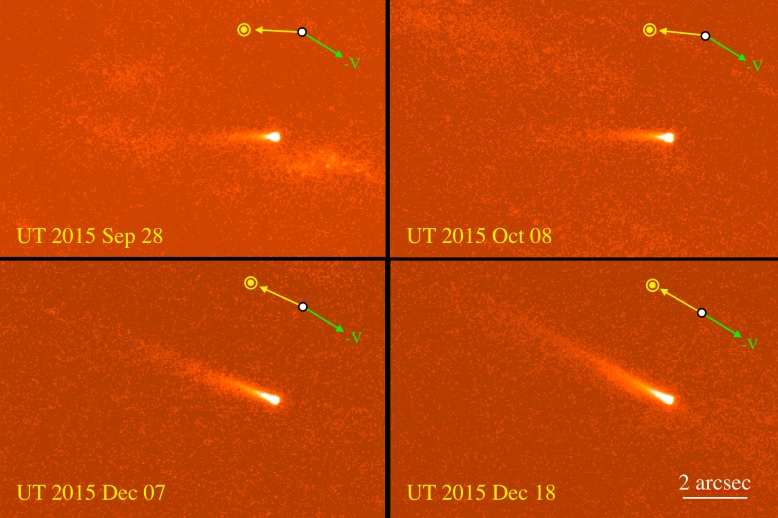July 5, 2016 report
Active asteroid 324P/La Sagra observed by Hubble

(Phys.org)—The renowned Hubble Space Telescope (HST) plays a leading role in uncovering distant locations of the universe, but it could be also a helpful tool for studying nearby objects, like space rocks whizzing through our solar system. Recently, a team of astronomers used Hubble to get a glimpse of the active asteroid 324P/La Sagra in order to unravel dynamic processes occurring on its surface. Their findings, published June 28 in a paper on arXiv.org, could improve our understanding of active asteroids.
Active asteroids like 324P/La Sagra, are bodies with asteroid-like orbits, which also show transient, comet-like activity. This activity could be caused by various physical processes, including impact, thermal fracture, rotational instabilities and ice sublimation. However, scientists still argue about whether these objects should be called "main-belt comets" (as they orbit the sun within asteroid belt) or rather asteroids exhibiting dust activity. Observing these bodies via powerful space telescopes such as Hubble could provide new insights into these processes and therefore the real nature of these objects.
Discovered in September 2010, 324P/La Sagra has a semimajor axis of about 3.1 AU and an eccentricity of 0.154. There was a great occasion to observe this object at the end of 2015 as it passed its perihelion on Nov. 30, 2015. That's why a team of astronomers led by David Jewitt of the University of California, Los Angeles, conducted Hubble observations of 324P/La Sagra between Sept. 28, 2015 and Dec. 18, 2015.
"Hubble produces fantastic, high-resolution images that are essential for our work. We need the resolution—typically ten or more times better than from a ground-based telescope—to detect and study the tiniest features in 324P/La Sagra. We can see much more with Hubble than with other telescopes," Jewitt told Phys.org.
They found that 324P/La Sagra is so small that it cannot continue to be active as observed for much more than about 100,000 years. The team noted that either we are seeing it at a very special time, or it is inert or "dormant" most of the time, springing to life very briefly after a collision with a smaller body.
"For example, it might be 'on' for ten orbits, then 'off' for 10,000 orbits. If so, we have to conclude that 324P/La Sagra is the tip of the iceberg, and that many other icy asteroids exist but lurk in an inactive state," Jewitt said.
According to the paper, the observations of 324P/La Sagra near perihelion revealed continued mass loss consistent with the sublimation of near-surface ice. The team estimated that the asteroid loses about 40,000 metric tons in dust particles, during one orbit. If this trend continues, it would limit the lifetime of 324P/La Sagra to approximately 16,000 orbits, which equals 100,000 years.
However, the most essential question regarding 324P/La Sagra is the cause of this reported intense activity.
"Because 324P/La Sagra has shown repeated activity near closest approach to the Sun and because we have measured protracted periods of mass loss—unlike impulsive ejection that could be caused by a collision—we are pretty sure that it is driven by ice. This ice could be primordial, in the sense that it was trapped in the body as the asteroids formed and it could be related to the Earth's oceans, which are now thought to have been delivered from the outer asteroid belt where 324P/La Sagra orbits," Jewitt noted.
Thus, 324P/La Sagra could be a survivor of a population that has now been depleted, but which originally delivered water to the terrestrial planets. To confirm this hypothesis, the team aims to conduct further observations over the next few years, especially during the next perihelia, in order to collect more data.
"If it's icy, then we would expect additional activity at future perihelia, but maybe the rate of loss will slow down as the surface ice is used up," Jewitt concluded.
More information: Hubble Space Telescope Observations of Active Asteroid 324P/La Sagra, arXiv:1606.08522 [astro-ph.EP] arxiv.org/abs/1606.08522
Abstract
Hubble Space Telescope observations of active asteroid 324P/La Sagra near perihelion show continued mass loss consistent with the sublimation of near-surface ice. Isophotes of the coma measured from a vantage point below the orbital plane are best matched by steady emission of particles having a nominal size a∼ 100 μm. The inferred rate of mass loss, dMd/dt∼0.2 kg s−1, can be supplied by sublimation of water ice in thermal equilibrium with sunlight from an area as small as 930 m2, corresponding to about 0.2% of the nucleus surface. Observations taken from a vantage point only 0.6degr~from the orbital plane of 324P set a limit to the velocity of ejection of dust in the direction perpendicular to the plane, V⊥< 1 m s−1. Short-term photometric variations of the near-nucleus region, if related to rotation of the underlying nucleus, rule out periods ≤ 3.8 hr and suggest that rotation probably does not play a central role in driving the observed mass loss. We estimate that, in the previous orbit, 324P lost about 4×107 kg in dust particles, corresponding to 6×10−5 of the mass of a 550 m spherical nucleus of assumed density ρ = 1000 kg m−3. If continued, mass loss at this rate would limit the lifetime of 324P to ∼1.6×104 orbits (about 105 yr). To survive for the 100 Myr to 400 Myr timescales corresponding, respectively, to dynamical and collisional stability requires a duty cycle 2×10−4≤fd≤8×10−4. Unless its time in orbit is over-estimated by many orders of magnitude, 324P is revealed as a briefly-active member of a vast population of otherwise dormant ice-containing asteroids.
© 2016 Phys.org





















